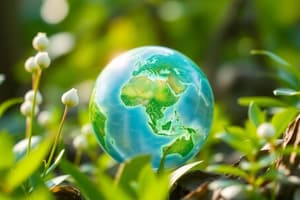Podcast
Questions and Answers
Ecology is best defined as the study of:
Ecology is best defined as the study of:
- The chemical composition of ecosystems.
- The natural history of organisms.
- The interactions between organisms and their environment. (correct)
- The classification of living things.
The biosphere includes only the parts of Earth with liquid water.
The biosphere includes only the parts of Earth with liquid water.
False (B)
The study of interactions between a group of the same species and factors that affect dynamics like birth and death rates is ______ ecology.
The study of interactions between a group of the same species and factors that affect dynamics like birth and death rates is ______ ecology.
population
Which factor is an example of an abiotic component of the environment?
Which factor is an example of an abiotic component of the environment?
Which level of ecological study focuses on the interconnectedness of different species within a defined area?
Which level of ecological study focuses on the interconnectedness of different species within a defined area?
What is the primary focus of ecosystem ecology?
What is the primary focus of ecosystem ecology?
Landscape ecology focuses on individual ecosystems rather than the connections between them.
Landscape ecology focuses on individual ecosystems rather than the connections between them.
Exchanges of energy, materials and organisms across multiple ecosystems are the focus of:
Exchanges of energy, materials and organisms across multiple ecosystems are the focus of:
Global ecology examines how energy influences organisms:
Global ecology examines how energy influences organisms:
Ecology provides all the necessary information for making environmental decisions.
Ecology provides all the necessary information for making environmental decisions.
The long-term prevailing weather conditions in a region constitute its ______.
The long-term prevailing weather conditions in a region constitute its ______.
What is the most significant influence on the distribution of organisms?
What is the most significant influence on the distribution of organisms?
List the four major components of climate.
List the four major components of climate.
Latitudinal variation in climate is primarily due to consistent and equal heating of Earth's surface.
Latitudinal variation in climate is primarily due to consistent and equal heating of Earth's surface.
Direct rays of sunlight are mainly received at:
Direct rays of sunlight are mainly received at:
Earth's tilt does not affect seasonal variations in sunlight intensity.
Earth's tilt does not affect seasonal variations in sunlight intensity.
The unequal heating of Earth causes air circulation and wind patterns, which then drive ______ currents.
The unequal heating of Earth causes air circulation and wind patterns, which then drive ______ currents.
What affect does proximity to water have on the climate of a region?
What affect does proximity to water have on the climate of a region?
The 'rain shadow effect' primarily affects which climate factor?
The 'rain shadow effect' primarily affects which climate factor?
Microclimates refer only to large-scale regional climate patterns.
Microclimates refer only to large-scale regional climate patterns.
The non-living chemical and physical attributes of the environment are called:
The non-living chemical and physical attributes of the environment are called:
Provide an example of a species whose geographic range is shrinking due to climate change.
Provide an example of a species whose geographic range is shrinking due to climate change.
A major life zone characterized by vegetation type and physical environment is called:
A major life zone characterized by vegetation type and physical environment is called:
Which of the following factors primarily determines the nature and location of Earth's biomes?
Which of the following factors primarily determines the nature and location of Earth's biomes?
Boundaries between biomes are always distinct and easily defined.
Boundaries between biomes are always distinct and easily defined.
What is the term for the area of integration between two biomes?
What is the term for the area of integration between two biomes?
Fires are always detrimental to biomes.
Fires are always detrimental to biomes.
What is 'turnover' in the context of lake zonation?
What is 'turnover' in the context of lake zonation?
The largest part of the biosphere is comprised of:
The largest part of the biosphere is comprised of:
Marine biomes exhibit more latitudinal variation compared to terrestrial biomes.
Marine biomes exhibit more latitudinal variation compared to terrestrial biomes.
Which zone in aquatic biomes is defined by light penetration?
Which zone in aquatic biomes is defined by light penetration?
Which of the following factors is NOT used to characterize aquatic biomes?
Which of the following factors is NOT used to characterize aquatic biomes?
The result of ecological and evolutionary interactions through time is species ______.
The result of ecological and evolutionary interactions through time is species ______.
Which factor would be studied by an ecologist when investigating the dispersion of a population?
Which factor would be studied by an ecologist when investigating the dispersion of a population?
The movement of individuals away from centers of high population density is known as:
The movement of individuals away from centers of high population density is known as:
Habitat-selection behavior does not limit species distribution.
Habitat-selection behavior does not limit species distribution.
A set of physical conditions is the:
A set of physical conditions is the:
Herbivory, parasitism and mutualism are all:
Herbivory, parasitism and mutualism are all:
Match the following levels of ecological study with their descriptions:
Match the following levels of ecological study with their descriptions:
Which of the following best describes the focus of organismal ecology?
Which of the following best describes the focus of organismal ecology?
Ecology is solely based on observing natural history, without experimental components.
Ecology is solely based on observing natural history, without experimental components.
What are the two major components that the 'environment' is split into?
What are the two major components that the 'environment' is split into?
The sum of all the planet's ecosystem create the _______.
The sum of all the planet's ecosystem create the _______.
Which level of ecological study focuses on the factors that affect population dynamics, such as birth and death rates?
Which level of ecological study focuses on the factors that affect population dynamics, such as birth and death rates?
Climate is considered the least significant influence on the distribution of organisms.
Climate is considered the least significant influence on the distribution of organisms.
Name the four components of weather that are also the components of climate.
Name the four components of weather that are also the components of climate.
The long-term prevailing weather conditions in a region is termed ________.
The long-term prevailing weather conditions in a region is termed ________.
What primarily influences latitudinal variations in climate on Earth?
What primarily influences latitudinal variations in climate on Earth?
Earth's tilt has no effect on sunlight intensity
Earth's tilt has no effect on sunlight intensity
What is the term for localized patterns in climatic conditions?
What is the term for localized patterns in climatic conditions?
Non-living chemical and physical attributes are called _______ factors.
Non-living chemical and physical attributes are called _______ factors.
Match the following ecology fields to the description:
Match the following ecology fields to the description:
Which of the following is a characteristic of terrestrial biomes?
Which of the following is a characteristic of terrestrial biomes?
There are totally distinct boundaries between Biomes.
There are totally distinct boundaries between Biomes.
Name three examples of disturbances that ecological stability.
Name three examples of disturbances that ecological stability.
The largest part of the biosphere, also characterized by biotic and abiotic factors, is ________.
The largest part of the biosphere, also characterized by biotic and abiotic factors, is ________.
What percentage of Earth's surface do oceans cover?
What percentage of Earth's surface do oceans cover?
Marine biomes have high latitudinal variation.
Marine biomes have high latitudinal variation.
What term describes the semiannual mixing of lake waters?
What term describes the semiannual mixing of lake waters?
Flashcards
What is ecology?
What is ecology?
The study of interactions between organisms and their environment.
What is the biosphere?
What is the biosphere?
The part of Earth that supports life; sum of all ecosystems.
What is an organism?
What is an organism?
A living creature capable of growth and reproduction that responds and adapts to its environment over time.
What are abiotic factors?
What are abiotic factors?
Signup and view all the flashcards
What are biotic factors?
What are biotic factors?
Signup and view all the flashcards
What is organismal ecology?
What is organismal ecology?
Signup and view all the flashcards
What is population ecology?
What is population ecology?
Signup and view all the flashcards
What is community ecology?
What is community ecology?
Signup and view all the flashcards
What is ecosystem ecology?
What is ecosystem ecology?
Signup and view all the flashcards
What is landscape ecology?
What is landscape ecology?
Signup and view all the flashcards
What is global ecology?
What is global ecology?
Signup and view all the flashcards
What is climate?
What is climate?
Signup and view all the flashcards
What are microclimates?
What are microclimates?
Signup and view all the flashcards
What are biomes?
What are biomes?
Signup and view all the flashcards
What is an ecotone?
What is an ecotone?
Signup and view all the flashcards
Disturbances
Disturbances
Signup and view all the flashcards
Abiotic Factors
Abiotic Factors
Signup and view all the flashcards
Biotic Factors
Biotic Factors
Signup and view all the flashcards
What is dispersal?
What is dispersal?
Signup and view all the flashcards
Study Notes
- Ecology is the study of interactions between organisms and their environment
- Ecology is an experimental science, not just natural history
- Oikos means home
- The biosphere is the part of Earth that supports life
- The biosphere is the sum of the planet's ecosystems
Organisms and Environment
- An organism is a living creature that can grow and reproduce
- The goal of an organism is to grow and reproduce
- Organisms respond to their environment
- Organisms can adapt to their environment over time via evolution
- Abiotic environment is the physical environment
- The biotic environment involves interactions between organisms
- The environment affects distribution and abundance of organisms
Levels of Inquiry in Ecology
- Organismal ecology studies the physiology, behavior, and evolutionary history of a species
- Organismal ecology looks at how the organism interacts with its environment
- Population ecology studies the factors that affect population dynamics like birth and death rates
- Community ecology studies groups of populations of different species
- Community ecology studies how interactions between species affect community structure like predation and competition
- Community ecology examines how members of a community interact and focuses on the interconnectedness of different species
- Ecosystem ecology studies groups of organisms along with the physical factors they interact with
- Energy flow and chemical cycling between organisms and the environment are part of ecosystem ecology
- Landscape ecology studies many connected ecosystems
- Landscape ecology studies factors controlling exchanges of energy, materials, and organisms across multiple ecosystems, such as dispersal corridors
Nutrient Flow Example
- Mangrove forests, seagrass beds, and coral reefs are connected
- Mangroves provide protection from predators
- Marine organisms use mangroves as a nursery
- Seagrass beds act as a corridor to the coral reef as organisms mature
- This whole system exemplifies landscape ecology
Ecology and Global Systems
- Organisms form populations, mixtures of populations form communities
- A variety of communities form ecosystems
- All ecosystems together make up the biosphere
- Global ecology examines the influence of energy and materials on organisms across the biosphere
Ecology and Environmental Issues
- Ecology offers a scientific foundation for addressing environmental problems
- This is just one component of decision-making that includes social, economic, and political factors
- Environmental science encompasses many disciplines
- Rachel Carson is credited with initiating the modern environmental movement
- Silent Spring was published in 1962
Climate Factors
- Climate is the most significant factor influencing the distribution of organisms
- Climate refers to long-term prevailing weather conditions in a region
- Climate has four components including temperature, precipitation, sunlight, and wind
- Global climate patterns are influenced by latitudinal variations in climate due to unequal heating of Earth's surface
- Direct sunlight at the equator and low angles of incidence at higher latitudes impacts global climate patterns
- Earth's tilt and elliptical orbit also cause seasonal variation in sunlight intensity
- Unequal heating causes air circulation and wind patterns, which then affect ocean currents
- Regional climate is impacted by proximity to water, which moderates the climate
- Regional climate is also affected by elevation and the rain shadow effect
- Topography impacts air movement, affecting local temperature and rainfall
- Latitude affects the accumulation of solar radiation
- Microclimates are localized patterns in climatic conditions
- Microclimates occur due to factors like shade, evaporation, and wind patterns
- Each environment on Earth has small-scale differences in abiotic i.e. non-living -- chemical, physical attributes and biotic i.e. living – interactions with other living organism factors
Global Climate Change
- Earth has warmed an average of 0.8°C since 1900
- Earth is predicted to warm 1-6°C more by 2100
- A major concern is whether species can shift their distributions quickly enough in response to climate changes
- Tree lines are advancing north as an example of climate change
- Some species face a shortage of suitable replacement habitats due to climate change
- A 2015 study shows that the geographic ranges of 67 bumblebee species in the Northern Hemisphere were shrinking
Biomes
- Climate determines the nature and location of Earth’s biomes
- Biomes are major life zones characterized by temperature, precipitation, dominant vegetation types, and physical environment
- Tropical Rain Forests exist, location and climate determine this
Biome Facts
- Tropical Dry Forests exist, location and climate determine this
- Deserts exist, location and climate determine this
- Savannas exist, location and climate determine this
- Chaparral zones exist, location and climate determine this
- Temperate grasslands exists, location and climate determine this
- Northern Coniferous Forests are the largest terrestrial biomes. Factors of location and climate determine this
- Temperate Broadleaf Forests exist, location and climate determine this
- Tundra exists, location and climate determine this
Terrestrial Biomes
- There are no distinct boundaries between biomes
- Areas of integration are called ecotones
- Vertical layering is also important
Disturbances
- Disturbances are seen more often than stability
- Storms, fires, and human activities are examples of disturbances
- Disturbances allow opportunity for new species to colonize
- Disturbances cause biomes to experience patchiness
- Fires are essential for regeneration in some biomes
Aquatic Biomes
- The aquatic biome is the largest part of the biosphere
- The aquatic biomes are characterized by abiotic and biotic factors
- Aquatic Biomes can be marine or freshwater
- Aquatic biomes show less latitudinal variation compared to terrestrial biomes
- Marine biomes have salt concentrations of about 3%
- Oceans cover 75% of Earth's surface
Aquatic Biome Features
- Characterized by physical/chemical environment, geological features, photosynthetic organisms, and heterotrophs
- Stratification in aquatic biomes is defined by light penetration, temperature, distance from shore and depth, open water versus bottom
- Many lakes undergo semiannual mixing of their waters called turnover
- Turnover mixes oxygenated water from the surface with nutrient-rich water from the bottom
- Clear thermoclines exist in some parts of the year
- Some aquatic biomes are freshwater lakes, streams, rivers and wetland.
- Some aquatic biomes are freshwater/marine water, estuaries
- Some aquatic biomes are marine based, intertidal zones, oceanic pelagic biome, coral reefs, and marine benthic zone
Ecology Factors
- Factors of species distribution and ecological interactions are the result of evolutionary interactions through time
- Ecologists question where species occur and why
- Dispersal is when individuals or gametes move away from centres of high population density or from their area of origin
- Dispersal contributes to the global distribution of organisms
- Natural range expansions show the influence of dispersal on the distribution
- Some organisms do not occupy their potential range
- Species distribution may be limited by habitat selection behaviour
- Abiotic factors affecting distribution of organisms include temperature, water, oxygen, salinity, sunlight, wind, and rocks and soil
- Biotic factors that affect the distribution of organisms include predation, herbivory, competition, mutualism, and parasitism
- Sea urchins can limit the distribution of seaweeds
Biogeography
- This is the broad distribution patterns of organisms based on biotic and abiotic factors
Studying That Suits You
Use AI to generate personalized quizzes and flashcards to suit your learning preferences.




